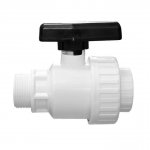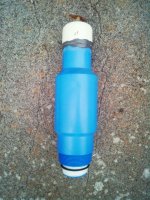My skimmer is connected to my drain but they are connected via individual ball valves and a T fitting to the pump back at my pump house. However, I installed a valve on my skimmer widget that would still enable the establishment of a pressure lock at the drain for the minority of forum members you mentioned. Perhaps I would buy a quicker to open/close valve than the one I installed on the top end of my skimmer widget, though I think I could make do with what I've got too.
Here's how I've done it now four times for our N. Central Idaho winters. (I just opened only yesterday with 59 degree water, due to a long cold winter and spring but, like previous years, I still had a solid airlock and a lot of air came out as the water rushed into the drain when I opened the airlock.)
Though there are other methods and tools that would work, I modified a skimmer widget and attached a brass valve on its top end. I used this kind of valve:
https://www.amazon.com/Air-Compressor-Drain-Valve-Tank/dp/B075JP2CS7
It's not easy to attach it to the skimmer widget though, because it's tough to get an adhesive to bond to the blue polyethylene plastic (or whatever it is). I was able to rough up the blue plastic on a coarse belt sander and then bond a PVC cap to it with JB Weld, I also applied a nice fillet along the cap edge too. The PVC cap has enough meat on its end to drill and tap it for a valve. I've often thought that someone should produce a skimmer widget with a valve so maybe it already exists!
I next close my multiport valve to my returns to only enable only the the airflow/waterflow between the skimmer and the drain. I deal with the returns last. Sometimes I install a rubber plug at this time to seal the input from the skimmer/drain T-fitting to the pump, which is probably less risky to the expensive and fragile multiport "spider" o-ring seal, if too much air pressure were to be applied while clearing the water from the drain plumbing. (Worst case, only the rubber plug might blow-out, with some force though!) Other times I install the rubber plug as backup to my ball valves later.
After installing my modified widget in the skimmer port, I use a rubber-tipped air blow gun, with tip inserted strongly against the open widget valve, to clear the line of water (valve opened just enough to get good airflow with no "extra turns" open on the valve that would slow closing it). I blow the lines out until big bubbles blow out the drain and then I yell for my assistant to close the Pentair ball valve to the drain while I simultaneously close the skimmer widget's valve. To make this work having no ball valves in the system, one would fully close the valve on the skimmer widget before fully removing the air supply. I try to adjust my air compressor regulator to an adequate plumbing safe value--say 40 psi max.
Just in case my ball valves leak a little, I make sure the widget's o-ring seals at the bottom end too, but I also back it up with a good application of Teflon tape on its threads. In the case where the plumbing between the skimmer and drain remain connected, the widget's seal and its installed valve seal must remain air-tight for the entire winter to maintain the airlock in the drain plumbing, as must the connection on the pump end too. Though necessary for a system lacking the ball valves, I only endeavor to make my skimmer line air-tight for backup purposes. I also remove the pump's input side from the plumbing and I place a rubber stopper into the PVC pipe that feeds the pump. Again, I don't trust the drain ball valve to hold the pressure lock alone.
In my case, I've already drained the water level down below the skimmer so no water can enter the simmer line so there's no rush to establish these "backup" precautions.
This is our fifth season with our pool in Idaho and I lost some sleep after closing the first couple of years, but it's worked very well for me. It's also possible for me first clear the drain with the airlock at its ball valve and then dump a couple of gallons of pool antifreeze (insurance) down the skimmer plumbing. By quickly opening the drain ball valve while applying air pressure to the skimmer a second time, I can drive some antifreeze into the drain plumbing, but the timing has to be just right to stop the air flow and re-establish the pressure lock just as the bubble first come out the drain. Otherwise all, or nearly all, of the antifreeze will just be blown into the pool! It's easy to have to start all over again, if the timing is off and I don't think this "insurance" is necessary, but then again, my airlocks have always held.
The returns are a similar process, but I connect the air hose to the pump's strainer side and drive the water and then air out the returns while I plug them with rubber stoppers (still below water level...brrrr!) when they bubble well. On the last return, I call for my assistant to quickly dial the air compressor regulator to zero as I shove in the last return plug. Simply pulling the hose is too quick for my timing!
The foam method might be more reliable, especially given no "backup" seal precautions, but I hate shoving anything down my skimmer, and I'd fear that some part of the foam blockage might become dislodged and become permanent. I'd certainly not want to forget to remove it and suck it further down the line when starting the pump back up!




